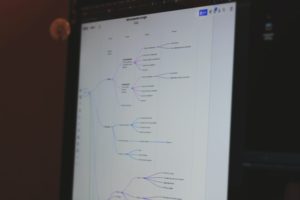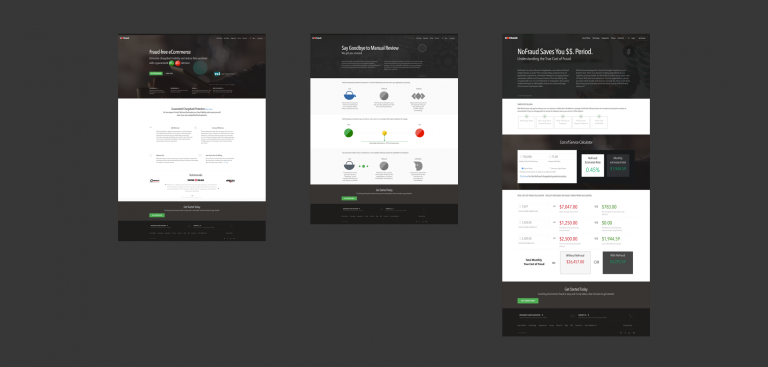In the past, I’ve blogged about applying Agile methodology to businesses at large: what we are seeing in business today is that the concept of “business transformation” isn’t something that is undergone once or even periodically – business transformation is becoming a continuous process.
Today, businesses at large – not just their creative and development silos – benefit from operating in an Agile manner, most importantly in the area of responding to change over following a plan. Consider the words of Christa Carone, chief marketing officer for Xerox:
“Where we are right now as an enterprise, we would actually say there is no start and stop because the market is changing, evolving so rapidly. We always have to be aligning our business model with those realities in the marketplace.”
This is an interesting development, but how, technically, can businesses achieve True Interaction in a continually transforming world?
Business Transformation: Reliance upon BI and Analytics
In order for an organization’s resources to quickly and accurately make decisions regarding a product, opportunity or sales channel, they must rely upon historic and extrapolated data, provided by their organization’s company’s Data Warehouse/Business Analytics group.
In a 2016 report by ZS Associates that interviewed 448 senior executives and officials across a myriad of industries, 70% of the respondents replied that sales and marketing analytics is already “very important” or “extremely important” to their business’ competitive advantage. Furthermore the report reveals that in just 2 years time, 79% of respondents expect this to be the case.
However, some very interesting numbers reveal cracks in the foundation: Only 12% of the same respondents could confirm that their organization’s BI efforts are able to stay abreast of the continually changing industry landscape. And only 2% believe business transformation in their company has had any “broad, positive impact.”
5 Reasons for lack of BI impact within an organization
1) Poor Data Integration across the business
Many Legacy BI systems include a suite (or a jumbled mess) of siloed applications and databases: There might be an app for Production Control, MRP, Shipping, Logistics, Order Control, for example, with corresponding databases for Finance, Marketing, Sales, Accounting, Management Reporting, and Human Resources – in all, creating a Byzantine knot of data hookups and plugins that are unique, perform a singular or limited set of functions, and are labor intensive to install, scale and upgrade.
2) Data collaboration isn’t happening enough between BI and Business Executives
Executives generally don’t appear to have a firm grasp of the pulse of their BI: only 41% of ZS Associates’ report participants thought that a collaborative relationship between professionals working directly with data analytics and those responsible for business performance exists at their company.
3) Popular Big Data Solutions are still siloed
Consider Ed Wrazen’s critique of Hadoop: During an interview at Computing’s recent Big Data and Analytics Summit, the Vice-President of Product Management at data quality firm Trillium Software revealed:
“My feeling is that Hadoop is in danger of making things worse for data quality. It may become a silo of silos, with siloed information loading into another silo which doesn’t match the data that’s used elsewhere. And there’s a lot more of it to contend with as well. You cannot pull that data out to clean it as it would take far too long and you’d need the same amount of disk storage again to put it on. It’s not cost-effective or scalable.”
4) Data Integration is still hard to do.
Only 44% of ZS Associates’ report ranked their organizations as “good” or “very good” at data aggregation and integration. 39% said that data integration and preparation were the biggest challenges within the organization, while 47% listed this as one of the areas in their organization where its improvement would produce the most benefit.
5) Only part of the organization’s resources can access BI
Back in the day, BI used to be the sole province of data experts in IT or information analyst specialists. Now companies are seeing the benefits of democratizing the access and analysis of data across the organization. Today, a data analyst could be a product manager, a line-of-business executive, or a sales director. In her book Successful Business Intelligence, Cindi Howson, author and instructor for The Data Warehousing Institute (TDWI) famously remarked:
“To be successful with BI, you need to be thinking about deploying it to 100% of your employees as well as beyond organizational boundaries to customers and suppliers… The future of business intelligence centers on making BI relevant for everyone, not only for information workers and internal employees, but also beyond corporate boundaries, to extend the reach of BI to customers and suppliers.”
Business leaders should examine these symptoms in the context of their own organizations.
Is there a solution to these issues?
True Interaction CEO O. Liam Wright has a novel approach to a new kind of BI solution. One that involves machine learning.
“In my 20 years in the business I’ve discovered several worlds in business that never spoke to each other properly, due to siloed information spaces, communications, platforms and people. Today’s fluid world necessitates changing the BI game completely: If you want to have a high level of true interaction between your systems, platforms, customers, internal multiple hierarchical department structures, then you NEED to flip the game around. SQL-based Dashboards are old news; they are so 2001.
You can’t start with a structured, SQL based situation that inevitably will require a lot of change over time – organizations don’t have the IT staff to continually support this kind of situation – it’s too expensive.”
Instead Liam took a different approach from the beginning:
I thought, what if we capitalized on the sheer quantity and quality of data today, and captured data in unstructured (or structured) formats, and put this data into a datastore that doesn’t care what type of data it is. Then – as opposed to expensive rigid, SQL-based joins on data types, instead we implement lightweight “builds” on top of the data. These lightweight builds enable businesses to start creating software experiences off of their base dataset pretty quickly. They also enable organizations to get Business Intelligence right out of the box as soon as they perform a build – dynamic dashboards and data visualizations which can be come much more sophisticated over time, as you pull in and cross-pollinate more data. Then, when the data is further under control, you can create software agents that can assist you in daily processes of data, or agents that get those controls out the door.
What is this BI and Machine Learning marriage, exactly?
So what exactly is Liam describing? Modern Business has just crossed over the threshold into an exciting new space – organizations can routinely implement an integrated Machine Learning component that runs in the background, that can ingest data of all types from any number of people, places, and platforms, intelligently normalize and restructure it so it is useful, run a dynamic series of actions based upon data type and whatever specified situations contexts your business process is in, and create dynamic BI data visualizations out-of-the-box.
True Interaction’s machine learning solution is called SYNAPTIK.
SYNAPTIK involves 3 basic concepts:

DATA: SYNAPTIK can pull in data from anywhere. Its user-friendly agent development framework can automate most data aggregation and normalization processes. It can be unstructured data, from commerce, web, broadcast, mobile, or social media. It can be audio, CRM, apps, or images. It also can pull in structured data for example, from SAP, Salesforce, Google, communications channels, publications, Excel sheets, or macros.
AGENT: A software agent is a program that acts for a user or other program in a relationship of agency, to act on one’s behalf. Agents can be configured to not only distribute data intelligence in flexible ways but also directly integrate and take action in other internal and external applications for quicker transformation to enhance your business processes and goals.
An Agent is composed of two parts: The operator and the controls. Think of an operator as the classic Telephone Operator in the 1940s that manually plugged in and unplugged your calls in the background. SYNAPTIK enables you to see how the operator works:

Operators can be written in several forms, such as Javascript, PHP / cURL, or Python. Organizations can write their own operators, or True Interaction’s development team can write them for you. An Agent also gives the user a control interface – a form field, or drag and drop functionality, in order to add specific assets, or run any variety of functions. In addition SYNAPTIK makes it easy to connect to a REST API, enabling developers to write their own own software on top of it.
BUILD: A build simply brings the DATA & AGENT components together, ultimately to enable you to better understand your organizations various activities within your data space.

A new model of BI: What is the Return?
– Machine Learning Platforms like SYNAPTIK enables organizations to create wide and deep reporting, analytics and machine learning agents without being tied to expensive specific proprietary frameworks and templates, such as Tableau. SYNAPTIK allows for blending of internal and external data in order to produce new valuable insights. There’s no data modeling required to drop in 3rd party data sources, so it is even possible to create reporting and insight agents across data pools.
– With traditional methods, the process of data normalization requires hours and hours of time – indeed the bulk of time is spent on this today. This leaves very little time for deep analysis and no time for deep insight. With SYNAPTIK, what takes 400 monthly hours to data manage now takes 2 minutes, opening up 399.99 hours of analysis, discovery, and innovation time to deliver the results you need.
– Not only is it possible create your own custom reports/analytic agents, SYNAPTIK enables organizations to share their reporting agents for others to use and modify.
– The inherent flexibility of SYNAPTIK enables businesses to continually provide new data products/services to their customers.
– Not so far down the line: Establishment of The Synaptik Marketplace, where you can participate, monetize, and generate additional revenue by allowing others to subscribe to your Agents and/or Data.
All of these returns contribute to not only augmenting organizational leadership and innovation throughout its hierarchy, but also producing incredibly valuable intelligence monetization, break-thru revenue, as well as improved “client stickiness” with the rollout of new data products and services. And, best of all, it puts businesses into a flexible data environment that does, quite elegantly, enable continuous transformation as industries, markets, and data landscapes continue to change.
We’ve got the Experience you Need
True Interaction has logged 100,000’s of hours of research, design, development, and deployment of consumer products and enterprise solutions. Our services directly impact a variety of industries and departments through our deep experience in producing critical business platforms.
We Can Integrate Anything with… Anything
Per the endless variable demands of each of our global clients, TI has seen it all, and has had to do it all. From legacy systems to open source, we can determine the most optimal means to achieve operational perfection, devising and implementing the right tech stack to fit your business. We routinely pull together disparate data sources, fuse together disconnected silos, and do exactly what it takes for you to operate with tight tolerances, making your business engine hum. Have 100+ platforms? No problem. Give us a Call.







